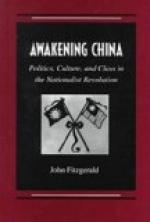This narrative comes from the Shu-King or “Book of History,” the most venerated of the Five Classics edited by Confucius; but the reader will readily perceive that it is no more historical than the stories of Codrus or Numa Pompilius.
In the reign of Yao we have an account of astronomical observations made with a view to fixing the length of the year. The King tells one man to go to the east and another to the west, to observe the culmination and transit of certain stars. As a result he says they will find that the year consists of 366 days, a close approximation for that epoch. The absurdity of this style, which attributes omniscience to the prince and leaves to his agents nothing but the task of verification, should not be allowed to detract from the credit due to their observations. The result arrived at was about the same as that reached by the Babylonians at the same date (2356 B. c.)
Other rulers who are credited with great inventions [Page 77] probably made them in the same way. Whether under Fuhi or Hwang-ti, Ts’ang-kie is recognised as the Cadmus of China, the author of its written characters; and Tanao, a minister of Hwang-ti, is admitted to be the author of the cycle of sixty. Both of those emperors may be imagined as calling up their ministers and saying to one, “Go and invent the art of writing,” and to the other, “Work out a system of chronology.”
In the same way, the inception of the culture of the silkworm and the discovery of the magnetic needle are attributed to the predecessors of Yao, probably on the principle that treasure-trove was the property of the King and that if no claimant for the honour could be found it must be attributed to some ancient monarch. The production of silk, as woman’s work, they profess to assign to the consort of one of those worthies—a thing improbable if not impossible, her place of residence being in the north of China. Their picture-writing tells a different tale. Their word for a southern barbarian, compounded of “silk” and “worm,” points to the south as the source of that useful industry, much as our word “silk,” derived from sericum, points to China as its origin.
[Page 78] CHAPTER XV
THE THREE DYNASTIES
The House of Hia—Ta-yu’s Consideration for His Subjects—Kie’s Excesses—The House of Shang—Shang-tang, the Founder, Offers Himself as a Sacrificial Victim, and Brings Rain—Chou-sin Sets Fire to His Own Palace and Perishes in the Flames—The House of Chou
The Hia, Shang and Chou dynasties together extend over the twenty-two centuries preceding the Christian Era. The first occupies 440 years; the second, 644; and the last, in the midst of turmoil and anarchy, drags out a miserable existence of 874 years. They are grouped together as the San Tai or San Wang, “the Three Houses of Kings,” because that title was employed by the founder of each. Some of their successors were called Ti; but Hwang-ti, the term for “emperor” now in use, was never employed until it was assumed by the builder of the Great Wall on the overthrow of the feudal states and the consolidation of the empire, 240 B. C.




